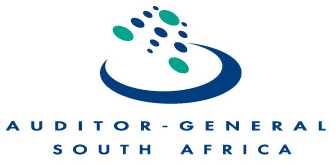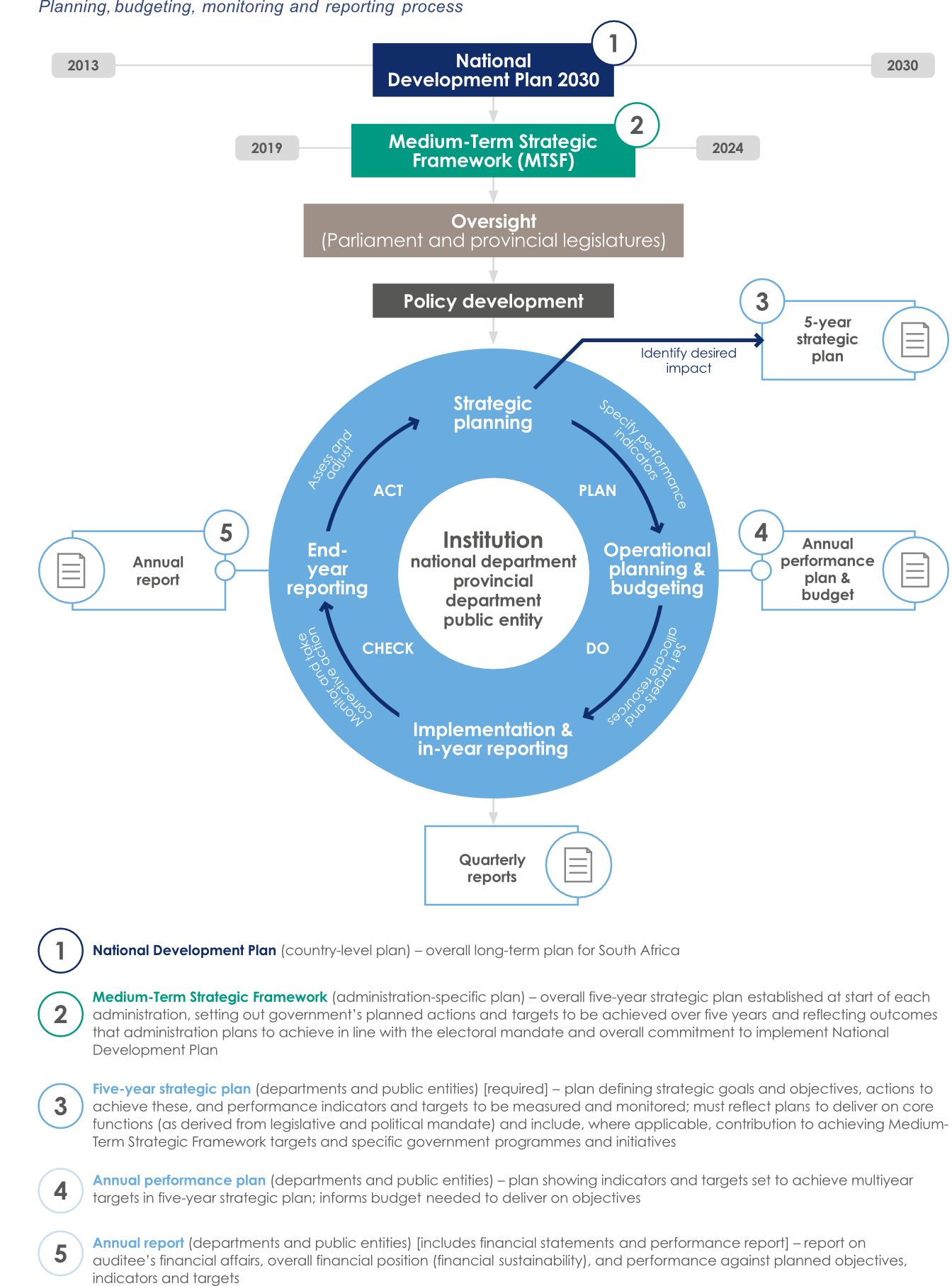Service delivery
Planning, reporting and oversight
National and provincial government are responsible for providing the basic services that the people of South Africa are entitled to as enshrined in the Constitution, such as healthcare, education, housing, safety and security, water and sanitation, social security, and an environment that is not harmful to health and wellbeing. They must also provide essential infrastructure and programmes that enable economic opportunities and growth.
In 2012, the government launched the long-term strategy for South Africa, known as the National Development Plan. The plan focuses on government’s long-term goals for systemically improving the wellbeing of the country and its people, with the aim of eliminating poverty and reducing inequality by 2030.
For government to successfully implement the National Development Plan and deliver on its service delivery mandate, requires multiple departments and public entities to systematically and purposefully plan and work together across the national and provincial spheres. They then need to report transparently on what they have achieved so that government can monitor and oversee their performance and provide opportunities for correction if they are not on track and address any shortcomings as early as possible.
Government’s planning, budgeting, monitoring and reporting processes have been well designed to support this basic plan-do-check-act process.
Auditees do not plan in isolation, as government was intended to work in a coordinated manner across the national, provincial and local spheres. Planning is done within specific portfolios, across delivery value chains and within sectors. Sectors are national and provincial departments that have the same (concurrent) functions, such as education, health and human settlements.
Even though there are well-designed processes with defined responsibilities for planning, achieving and reporting on auditees’ delivery on their mandates and on the Medium-Term Strategic Framework, these processes are poorly implemented and the public continues to experience a lack of delivery, particularly in the key service delivery portfolios.
In the remainder of this section, we focus on different matters characterising this poor implementation, namely inadequate annual planning; ineffective reporting, oversight and accountability processes; and underachievement on planned service delivery improvement.
Inadequate annual planning
In our audits, we assess the completeness of the performance indicators included in auditees’ annual performance plans to determine if the auditees are planning for delivering on their core mandated functions and for their role in achieving the Medium-Term Strategic Framework targets. We also audit whether the performance indicators and related targets are relevant and measurable. Our main findings on planning are outlined below.
Incomplete annual performance plans
The key service delivery portfolios play a vital role in achieving the Medium-Term Strategic Framework 2019-24 targets, but the annual performance plans of some of the auditees within these portfolios did not include indicators that measure their contribution to the Medium-Term Strategic Framework, their core functions, or the jobs they were created to perform.
We found that many auditees excluded Medium-Term Strategic Framework deliverables and indicators from their annual performance plans because the national sector departments could not ensure that the provinces follow a common and consistent approach in planning delivery on the Medium-Term Strategic Framework. We discuss this a little later in the section.
Some auditees also did their planning and reporting ‘off the books’. Although they continued to work towards delivery, they did not include this work in their plans or report on their achievements in this area; thereby not subjecting it to executive and oversight scrutiny as well as auditing. These auditees prefer to show good achievements on easier targets. For example, the Mpumalanga Department of Education included Medium-Term Strategic Framework indicators in its operational plan but not in the annual performance plan that it is required to report on.
Impact
- If departments and public entities exclude indicators from their annual performance plans and reports, they risk not being able to achieve the Medium-Term Strategic Framework targets. This means the administration may not be able to deliver on its promised services and improve the lives of the people of South Africa. A target that is not measured or accounted for, is unlikely to be delivered.
- Incomplete annual performance plans also mean auditees do not transparently report on how they perform their core functions and on their contributions to government programmes and initiatives. This weakens the accountability process because those who need to monitor and make decisions about government-wide deliverables, are not working with complete and reliable (audited) information.
Examples of Medium-Term Strategic Framework deliverables not included in annual performance plans
- The Department of Water and Sanitation did not include the Medium-Term Strategic Framework deliverable on eradicating the bucket sanitation system in its annual performance plan.
- More than half of the auditees in the key sectors did not include indicators in their plans for the following important Medium-Term Strategic Framework deliverables:
- Five of the nine auditees in the education sector did not include an indicator relating to grade 6 and 9 learners with access to required mathematics and English first additional language textbooks.
- Eight of the 10 auditees in the public works sector did not include an indicator for government- owned land parcels released towards spatial transformation and spatial justice.
- Eight of the 10 auditees in the human settlements sector did not include all four of the indicators related to the registration of title deeds.
Examples of core functions not included in plans
- One of the core legislated functions of the Department of Basic Education is to ensure the continued innovation of the school curriculum, but the department did not include indicators in its annual performance plan related to the revision of, and training in, the history curriculum that are due by 2023.
- The Eastern Cape Department of Health did not include the patient safety incident case closure rate in its annual performance plan, which is a key prioritised function within the district health services programme.
Indicators are activity based or not relevant and annual targets are set too low to achieve multiyear targets
The performance indicators that auditees include in their plans should be relevant for enabling accountability and assessing whether they will achieve the outcomes for which they are responsible. Achievement targets for these indicators should be informed by the desired level of performance and the allocated budget, and should be directed towards achieving the five-year targets.
Some auditees in the key service delivery portfolios, or coordinating institutions, included indicators in their annual performance plans that are mainly activity based (input driven) with limited or no focus on measuring output or outcomes that drive impact. In some cases, despite the urgent need for service delivery, the target was lower than required to achieve the Medium-Term Strategic Framework target. We have found that this is done often to create the perception that the auditee is performing well and that service delivery is taking place.
Impact
Reported performance is therefore not an accurate barometer for monitoring progress towards achieving Medium-Term Strategic Framework targets; and so, appropriate corrective action is not implemented in time.
Examples of annual target set too low to enable achievement of multiyear targets
-
The 31 March 2024 Medium-Term Strategic Framework target in the human settlements sector is the delivery of 300 000 serviced sites. However, over the first three years of the five-year plan, the sector’s target was
141 278 sites and not the proportional 180 000 that would have been expected. This lower than anticipated target creates a risk that the Medium-Term Strategic Framework target may not be achieved over the five- year period.
Examples of indicator not relevant
The South African Police Service is responsible for improving the processing of forensic services. In its annual performance plan, it measured the turnaround time in days taken to finalise fingerprint, ballistic and DNA samples received from the date of capturing evidence on the Forensic Scientific Laboratories System up to the final processing by the laboratory. However, laboratories only measured the time from when samples were sent for processing, and not immediately upon receipt. The turnaround time from when samples were collected from victims or suspects to when they were submitted for processing was also not measured. This means that the auditee did not measure or report on the actual time taken to finalise samples from the collection of these samples to the samples being processed and ready for court.
Examples of activity-based indicators
An important deliverable in the Medium-Term Strategic Framework is the creation of jobs through Operation Phakisa. The Department of Planning, Monitoring and Evaluation annually measures and reports on the number of integrated Operation Phakisa reports produced instead of the number of jobs created.
Limited consistency in planning and reporting across provinces for service delivery
Because sector departments have to achieve similar priorities and deliver similar services, indicators for planning and reporting should be standardised across the sector for consistency.
The Department of Planning, Monitoring and Evaluation issued new guidelines in 2020 on standardising indicators across sectors with concurrent functions to improve intergovernmental coordination on what and how to measure. Despite these guidelines, we found inconsistencies in how sector departments standardise indicators across provinces because of existing deficiencies and disagreements in coordination that had still not been addressed.
Impact
The lack of consistent planning and reporting within sectors makes it very difficult for national government to compare the performance of sector departments across provinces and to monitor and report on relevant government programmes and priorities.
Examples of challenges and inconsistencies in planning and reporting sector indicators across provinces
- The public works sector could not agree on standardised indicators and so key indicators such as the maintenance of properties and completion of infrastructure projects on time and within budget were not tracked consistently.
- The human settlements sector could not agree on standardised indicators and so some departments did not include indicators such as the number of title deeds registered and the number of serviced sites delivered.
Ineffective reporting, oversight and accountability processes
Every year, we audit selected material programmes of departments and objectives of public entities to determine whether the information in the annual performance reports is useful and reliable enough to enable oversight bodies, the public and other users of the reports to assess the auditee’s performance. We select programmes and objectives that align with the auditee’s mandate and we report findings that are material enough to be brought to the attention of these users in our audit reports.
When an auditee receives material findings on its annual performance report, this means that it generally struggled to:
- align its annual performance report to the predetermined objectives to which it committed in its annual performance plan
- set clear performance indicators and targets to measure its performance against its predetermined objectives
- report reliably on whether it has achieved its performance targets.
It does not bode well for service delivery that more than half of the 329 auditees that prepared annual performance reports submitted poor-quality performance reports for auditing.
Although there are performance management and reporting frameworks that clarify definitions and standards for performance information, including the requirements for systems and processes to manage such information, most departments and public entities did not have adequate systems to collate and report on their performance information. Performance management and reporting requirements were also not properly applied.
Impact
The poorly prepared annual performance reports and significant activity to make corrections in response to our audits also raise questions about the credibility of in-year reporting and the effectiveness of performance reporting throughout the year. Poor monitoring and corrective action throughout the year contribute to auditees being unable to achieve their performance targets or reliably report on their performance. Accounting officers and authorities and oversight bodies (such as portfolio committees) also use in-year reporting for monitoring purposes; without reliable information, their monitoring process will be ineffective.
The most prevalent material findings on performance reports were that information was not reliable or not useful.
Impact
- If information was not reliable, this means that either we had proof that the achievement as reported was not correct, or we could not find evidence to support it. In other words, the achievements reported may not have taken place at all or were fewer than those reported.
- If information was not useful, this means that what was reported had little relevance to the auditees’ original commitments in their planning documents, and anyone attempting to establish whether the commitments had been honoured would struggle to get a credible answer from the report.
The auditees in the key service delivery portfolios in particular struggled to produce useful and reliable reports, with 45% receiving material findings on the quality of their performance reporting, while 40% included information that was not reliable and 25% included information that was not useful.
While most auditees have adequate systems to collate and report on their performance information, officials did not properly apply the performance management and reporting requirements. The controls to prevent reporting on unreliable information were inadequate and the misstatements remained undetected even though the annual performance reports went through various levels of review.
This not only has a detrimental effect on service delivery, it also puts pressure on the auditors (and consequently on the audit fees) to identify matters that need to be corrected as part of the audit process.
Impact
When auditees do not have credible data and information, or adequate performance information systems, it affects their ability to plan for service delivery, respond to any potential challenges and make decisions. For example, if a department cannot reliably measure the number of schools that has access to sanitation facilities, they cannot respond to the needs of learners.
The deficiencies we identified in performance reporting during our audits show that the accountability value chain is not functioning as it should.
Problems with accountability value chain
Senior management, internal audit units and audit committees (responsible for designing and implementing required performance management controls):
- did not prevent and detect misstatements during the year due to the poor control environment
- did not promptly correct identified misstatements.
Accounting officers and authorities (depend on senior management for designing and implementing the required performance management controls, but are responsible for creating an environment that helps improve performance management controls):
- do not always create a conducive environment for performance management controls
- continue to sign off on annual performance reports that are not credible.
Those responsible for support, oversight, accountability and governance (executive authorities; Department of Planning, Monitoring and Evaluation; offices of the premier; legislatures; and portfolio committees):
- make decisions based on annual performance reports that are not credible because they:
- do not always pay sufficient attention or ask the right questions by interrogating information to identify the issues
- do not follow up on identified issues.
Learn more about the accountability ecosystem
There are two aspects to accountability: firstly, those who take actions or make decisions must answer for those actions or decisions; and secondly, those who do wrong (transgress), do nothing (fail to act) or perform poorly should face consequences. If reporting, oversight and accountability processes are not effective, this inevitably leads to poor performance and thus deprives South Africans of much-needed services.
Underachievement on planned service delivery improvement
To ensure that service delivery is on track, auditees must regularly monitor and report on how they are performing against their expenditure plans and targets. There could be valid reasons for targets not being achieved in a specific year. However, what was achieved should be compared against the budget because if not all targets were met, then not all funds should have been spent and there should be savings. Therefore, questions should be asked about the correlation between what was achieved and the budget used. Yet, we found that in some cases, all or almost all of the related budget had been spent even though planned targets were not fully achieved.
Impact
If the reported performance is not as expected and does not correlate with the budget spent, it will compromise the achievement of government’s priorities and erode future budgets meant for service delivery.
Our recommendations to enable complete annual and multiyear planning and reporting, accountability for effective reporting, and achievement of planned service delivery are as follows:
- Roleplayers responsible for government coordination must ensure that key service delivery targets are planned for by refocusing and energising performance planning processes so that they are comprehensive and include relevant targets aligned to auditee mandates, national strategic plans and sector priorities.
- Relevant roleplayers must strengthen the components of intergovernmental coordination across concurrent functions to avoid disagreements and inconsistencies in the planning and reporting of sector indicators so that sector priorities can be achieved.
- Auditees must have policies, procedures and monitoring mechanisms for proper record keeping and good internal controls to ensure that complete, relevant and accurate information is accessible and available to support performance reporting and to enable senior management to hold staff accountable for their actions.
- Accounting officers and authorities must enable and insist on in-year monitoring controls and project management disciplines so that planned service delivery targets can be achieved on time, within budget and at the required quality.
- Executive authorities must renew their commitment to accountability by enabling consequence management – starting with the performance agreements of accounting officers and authorities.
- Oversight structures must assess the strategic and performance plans of departments and public entities with the necessary vigour to effectively fulfil their oversight role and interrogate quarterly performance reports to ensure achievement of performance plans, strategic plans and the Medium-Term Strategic Framework.
Other pages in this section:
Other pages in this section:


